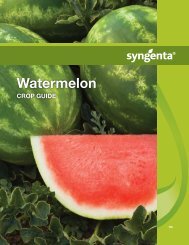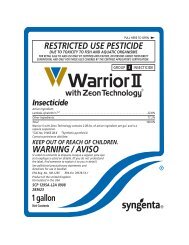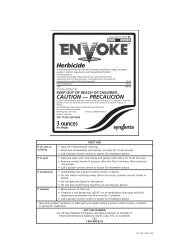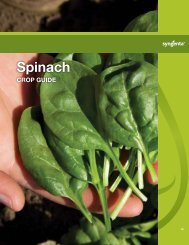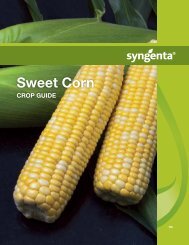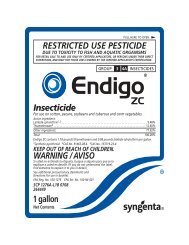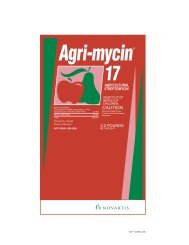MSDS - Syngenta
MSDS - Syngenta
MSDS - Syngenta
You also want an ePaper? Increase the reach of your titles
YUMPU automatically turns print PDFs into web optimized ePapers that Google loves.
MATERIAL SAFETY DATA SHEET<strong>Syngenta</strong> Crop Protection, Inc.Post Office Box 18300Greensboro, NC 274191. PRODUCT IDENTIFICATIONProduct Name: DSV ADJUVANTEPA Signal Word: CautionIn Case of Emergency, Call1-800-888-8372Product No.:Not AssignedEPA Registration Number(s): Not available2. COMPOSITION/INFORMATION ON INGREDIENTSSection(s) Revised: All sectionsMaterialOSHAPELACGIHTLVPetroleum Solvent Not Established Not Established 100 mg/m³ (15 ppm)TWA *Naphthalene 10 ppm (50 mg/m³) TWA 10 ppm (52 mg/m³) TWA(skin)Other10 ppm (50 mg/m³)TWA**Surfactant Not Established Not Established Not EstablishedPetroleum Hydrocarbon 5 mg/m³ TWA 5 mg/m³ TWA Not Established* recommended by manufacturer** recommended by NIOSHNTP/IARC/OSHACarcinogenNoNTP - AnticipatedNoNoIngredients not precisely identified are proprietary or non-hazardous. Values are not product specifications.3. HAZARDS IDENTIFICATIONSymptoms of Acute ExposureCauses eye, skin and respiratory passage irritation.Exposure to high vapor levels may cause headache, dizziness, numbness, nausea, incoordination, or other central nervoussystem effects.Hazardous Decomposition ProductsCan decompose at high temperatures forming toxic gases.Physical PropertiesAppearance: Light amber liquidOdor: Mild; aromaticUnusual Fire, Explosion and Reactivity HazardsDuring a fire, irritating and possibly toxic gases may be generated by thermal decomposition or combustion.4. FIRST AID MEASURESHave the product container, label or Material Safety Data Sheet with you when calling <strong>Syngenta</strong> (800-888-8372), a poisoncontol center or doctor, or going for treatment.Ingestion:If swallowed: Call <strong>Syngenta</strong> (800-888-8372), a poison control center or doctor immediately for treatmentadvice. Do not give any liquid to the person. Do not induce vomiting unless told to do so after calling 800-888-8372 or by a poison control center or doctor. Do not give anything by mouth to an unconscious person.Product Name:DSV ADJUVANTPage: 1
Eye Contact:Skin Contact:Inhalation:If in eyes: Hold eye open and rinse slowly and gently with water for 15-20 minutes. Remove contact lenses,if present, after 5 minutes, then continue rinsing eye. Call <strong>Syngenta</strong> (800-888-8372), a poison control centeror doctor for treatment advice.If on skin or clothing: Take off contaminated clothing. Rinse skin immediately with plenty of water for 15-20 minutes. Call <strong>Syngenta</strong> (800-888-8372), a poison control center or doctor for treatment advice.If inhaled: Move person to fresh air. If person is not breathing, call 911 or an ambulance, then give artificialrespiration, preferably mouth-to-mouth if possible. Call <strong>Syngenta</strong> (800-888-8372), a poison control center ordoctor for further treatment advice.Notes to PhysicianThere is no specific antidote if this product is ingested.Treat symptomatically.Contains petroleum distillate - vomiting may cause aspiration pneumonia.Medical Condition Likely to be Aggravated by ExposureIndividuals with chronic respiratory disorders or pre-existing dermatitis should use extra care in handling this product.5. FIRE FIGHTING MEASURESFire and ExplosionFlash Point (Test Method):Flammable Limits (% in Air):Autoignition Temperature:Flammability:378°F (Pensky-Martens CC)Lower: % Not ApplicableNot AvailableNot ApplicableUpper: % Not ApplicableUnusual Fire, Explosion and Reactivity HazardsDuring a fire, irritating and possibly toxic gases may be generated by thermal decomposition or combustion.In Case of FireUse dry chemical, foam or CO2 extinguishing media. Wear full protective clothing and self-contained breathingapparatus. Evacuate nonessential personnel from the area to prevent human exposure to fire, smoke, fumes or products ofcombustion. Prevent use of contaminated buildings, area, and equipment until decontaminated. Water runoff can causeenvironmental damage. If water is used to fight fire, dike and collect runoff.6. ACCIDENTAL RELEASE MEASURESIn Case of Spill or LeakControl the spill at its source. Contain the spill to prevent it from spreading, contaminating soil, or entering sewage anddrainage systems or any body of water. Clean up spills immediately, observing precautions outlined in Section 8. If asolid, sweep up material and place in a compatible disposal container. If a liquid, cover entire spill with absorbingmaterial and place into compatible disposal container. Scrub area with hard water detergent (e.g. commercial productssuch as Tide, Joy, Spic and Span). Pick up wash liquid with additional absorbent and place into compatible disposalcontainer. Once all material is cleaned up and placed in a disposal container, seal container and arrange for disposition.7. HANDLING AND STORAGEStore the material in a well-ventilated, secure area out of reach of children and domestic animals. Do not store food, beveragesor tobacco products in the storage area. Prevent eating, drinking, tobacco use, and cosmetic application in areas where there isa potential for exposure to the material. Wash thoroughly with soap and water after handling.8. EXPOSURE CONTROLS/PERSONAL PROTECTIONTHE FOLLOWING RECOMMENDATIONS FOR EXPOSURE CONTROLS/PERSONAL PROTECTION ARE INTENDED FORTHE MANUFACTURE, FORMULATION AND PACKAGING OF THE PRODUCT.FOR COMMERCIAL APPLICATIONS AND ON-FARM APPLICATIONS CONSULT THE PRODUCT LABEL.Ingestion: Prevent eating, drinking, tobacco usage and cosmetic application in areas where there is a potential forexposure to the material. Wash thoroughly with soap and water after handling.Product Name:DSV ADJUVANTPage: 2
Eye Contact:Skin Contact:Inhalation:Where eye contact is likely, use chemical splash goggles. Facilities storing or utilizing this material shouldbe equipped with an eyewash facility and a safety shower.Where contact is likely, wear chemical-resistant (such as nitrile or butyl) gloves, coveralls, socks andchemical-resistant footwear. For overhead exposure, wear chemical-resistant headgear.Use process enclosures, local exhaust ventilation, or other engineering controls to keep airborne levelsbelow exposure limits. A NIOSH-certified combination air-purifying respirator with an N, P or R 95 or HEclass filter and an organic vapor cartridge may be permissible under certain circumstances where airborneconcentrations are expected to exceed exposure limits. Protection provided by air-purifying respirators islimited. Use a pressure demand atmosphere-supplying respirator if there is any potential for uncontrolledrelease, exposure levels are not known, or under any other circumstances where air-purifying respiratorsmay not provide adequate protection.9. PHYSICAL AND CHEMICAL PROPERTIESAppearance:Odor:Light amber liquidMild; aromaticMelting Point:Not ApplicableBoiling Point:Not AvailableSpecific Gravity/Density: 0.93 @ 68°F (20°C) (Typical)pH:Not AvailableSolubility in H2OVapor Pressure10. STABILITY AND REACTIVITYStability:Hazardous Polymerization:Conditions to Avoid:Materials to Avoid:Hazardous Decomposition Products:Stable under normal use and storage conditions.Will not occur.Ignition sources.Temperatures below 63°F (17°C) or above 122°F (50°C).Strong oxidizers.Can decompose at high temperatures forming toxic gases.11. TOXICOLOGICAL INFORMATIONAcute Toxicity/Irritation Studies (Finished Product)Ingestion:Practically Non-ToxicOral (LD50 Rat) :Dermal:Slightly ToxicInhalation:Eye Contact:Skin Contact:Skin Sensitization:NeurotoxicityDermal (LD50 Rat) :Not AvailableInhalation (LC50 Rat) :Not AvailableNot AvailableNot Available> 10,000 mg/kg body weight> 2,000 mg/kg body weightNot AvailableReproductive EffectsChronic/Subchronic Toxicity StudiesCarcinogenicityProduct Name:DSV ADJUVANTPage: 3
Other Toxicity InformationNote: Data on the formulation or on the individual components of the formulation are not available for the abovecategories: "Neurotoxocity", "Reproductive Effects", "Chronic/Subchronic Toxicity Studies" and "Carcinogenicity".Data for "Solubility in H2O" and "Vapor Pressure" (Section 9) are not available for the formulation.Ecological Information (Section 12) is not available for the formulation.Toxicity of Other ComponentsPetroleum HydrocarbonAcute exposure may cause respiratory tract irritation. Excessive exposures may cause irritation to eyes, nose,throat and lungs.Petroleum SolventSupplier states that inhalation of vapors at high concentrations can cause central nervous system effects(dizziness, headache), irritation to eyes or respiratory tract. Skin exposure can cause defatting with resultingdermatitis. Damage to the stomach, liver, thyroid, and urinary bladder for high oral doses in rats, however, themanufacturer states that these effects are not relevent to humans at occupational levels of exposure.SurfactantTarget OrgansActive IngredientsNot AvailableInert IngredientsPetroleum Hydrocarbon:Petroleum Solvent:Surfactant:12. ECOLOGICAL INFORMATIONSummary of EffectsEco-Acute ToxicityMay cause eye irritation.Respiratory tract, eyeRespiratory tract, stomach, liver, thyroid, urinary bladder, CNS,skinEyeEco-Chronic ToxicityEnvironmental Fate13. DISPOSAL CONSIDERATIONSDisposalDo not reuse product containers. Dispose of product containers, waste containers, and residues according to local, state,and federal health and environmental regulations.Characteristic Waste: Not ApplicableListed Waste: Not Applicable14. TRANSPORT INFORMATIONDOT ClassificationNot regulated by DOT.B/L Freight ClassificationChemicals, NOIBNCommentsNoneProduct Name:DSV ADJUVANTPage: 4
15. REGULATORY INFORMATIONEPCRA SARA Title III ClassificationSection 311/312 Hazard Classes:Section 313 Toxic Chemicals:Acute Health HazardChronic Health HazardFire HazardNaphthalene (CAS No. 91-20-3)California Proposition 65Not ApplicableCERCLA/SARA 302 Reportable Quantity (RQ)> 1,800 lbs (based on naphthalene [RQ = 100] in the formulation)RCRA Hazardous Waste Classification (40 CFR 261)Not ApplicableTSCA StatusOn TSCA Inventory16. OTHER INFORMATIONNFPA Hazard RatingsHealth:Flammability:Instability:110HMIS Hazard RatingsHealth:Flammability:Reactivity:1100 Minimal1 Slight2 Moderate3 Serious4 ExtremeFor non-emergency questions about this product call:1-800-334-9481Original Issued Date:Revision Date:03/28/200003/06/2002Replaces:The information and recommendations contained herein are based upon data believed to be correct.However, no guarantee or warranty of any kind, expressed or implied, is made with respect to theinformation contained herein.RSVP# : SCP-955-00344AEnd of <strong>MSDS</strong>Product Name:DSV ADJUVANTPage: 5





